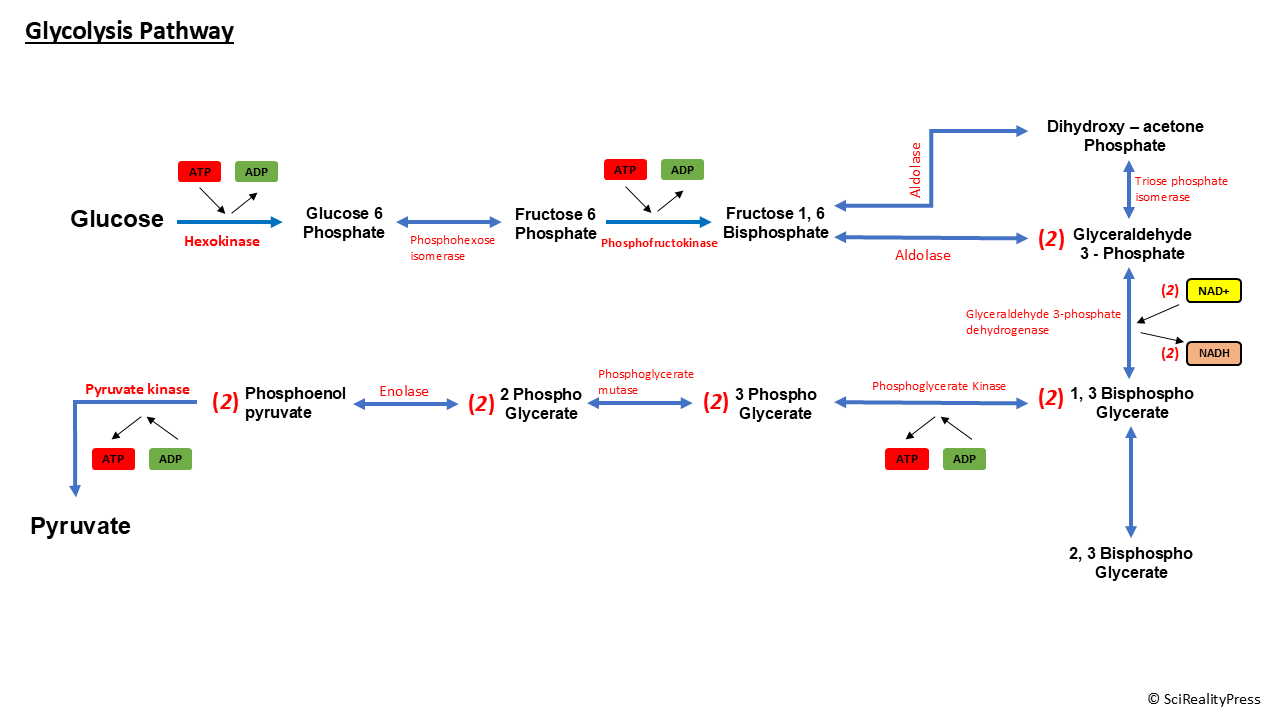Glycolysis is one of the most fundamental metabolic pathways found in nearly all living organisms. In glycolysis, a simple sugar (glucose) is broken down to produce energy in the form of ATP (adenosine triphosphate). This process takes place in the cell cytoplasm and is the first step in both aerobic and anaerobic respiration. Understanding this pathway is crucial in comprehending cellular metabolism, bioenergetics, and how cells convert nutrients into usable energy.
Overview of Glycolysis
The term “glycolysis” is derived from the Greek words “glykys,” meaning sweet, and “lysis,” meaning breaking down, that represents how the process breaks down glucose. Glycolysis is a sequence of ten enzymatic reactions that convert one molecule of glucose (6-carbon compound) into two molecules of pyruvate (3-carbon compound). During the process, energy captured appears in the form of ATP and NADH (nicotinamide adenine dinucleotide).
Phases of Glycolysis
- The Energy Investment Phase (Preparatory Phase)
- The Energy Payoff Phase (Payoff Phase)
Glycolysis Pathway

Energy Investment Phase
This step involves the use of two molecules of ATP to prime glucose for breakdown.
Phosphorylation of Glucose
Hexokinase/Glucokinase is the enzyme
Reaction: Glucose + ATP → Glucose-6-phosphate + ADP
Description: This is a step where glucose receives its first phosphate group when it combines with the enzyme hexokinase in most cells or glucokinase in liver and pancreatic cells. It will result in the removal of a phosphate group from ATP, which will be added to glucose to form glucose-6-phosphate. This prevents glucose from leaving the cell.
Isomerization of Glucose-6-Phosphate
Phosphoglucose isomerase is the enzyme
Reaction: Glucose-6-phosphate → Fructose-6-phosphate
Description: Fructose-6-phosphate is an isomerization reaction that the glucose-6-phosphate is rearranged; in other words, it converts a six-membered ring into a five-membered ring.
Phosphorylation of Fructose-6-Phosphate
Phosphofructokinase-1 (PFK-1) is the enzyme
Reaction: Fructose-6-phosphate + ATP → Fructose-1,6-bisphosphate + ADP
Description: In this crucial step, the second ATP is used in the phosphorylation of fructose-6-phosphate into fructose-1,6-bisphosphate. This is because the key regulatory enzyme phosphofructokinase-1 causes this step in glycolysis to be very controlled.
Cleavage of Fructose-1,6-Bisphosphate
Aldolase is the enzyme
Reaction: Fructose-1,6-bisphosphate → Dihydroxyacetone phosphate + Glyceraldehyde-3-phosphate
Description: Fructose-1,6-bisphosphate is broken into two three-carbon units; namely dihydroxyacetone phosphate (DHAP) and glyceraldehyde-3-phosphate (G3P).
Isomerization of DHAP
Triosephosphate isomerase is the enzyme.
Reaction: Dihydroxyacetone phosphate → Glyceraldehyde-3-phosphate
Description: DHAP is quickly converted into glyceraldehyde-3-phosphate, so at the end of the energy investment phase, two molecules of G3P are produced from one molecule of glucose.
Energy Payoff Phase
This stage produces energy in the form of ATP and NADH. Because two molecules of G3P are produced for every molecule of glucose, all reactions of this stage occur twice for each glucose.
Oxidation of Glyceraldehyde-3-Phosphate
Glyceraldehyde-3-phosphate dehydrogenase is the enzyme.
Reaction: Glyceraldehyde-3-phosphate + NAD⁺ + Pi → 1,3-bisphosphoglycerate + NADH + H⁺
Description: G3P is oxidized and phosphorylated to form 1,3-bisphosphoglycerate. The reaction also reduces NAD⁺ to NADH, an energy carrier in the form of an electron carrier.
Phosphorylation of ADP
Phosphoglycerate kinase is the enzyme.
Reaction: 1,3-Bisphosphoglycerate + ADP → 3-Phosphoglycerate + ATP
Description: This is an energy-rich phosphate group transferred from 1,3-bisphosphoglycerate to ADP to produce ATP. This is the first step in the production of ATP during the glycolytic cycle.
Isomerization of 3-Phosphoglycerate
Phosphoglycerate mutase is the enzyme.
Reaction: 3-phosphoglycerate → 2-phosphoglycerate
Description: The phosphate group of 3-phosphoglycerate is transferred from the 3rd carbon to the 2nd carbon, forming 2-phosphoglycerate.
Dehydration of 2-Phosphoglycerate
Enolase is the enzyme.
Reaction: 2-phosphoglycerate → Phosphoenolpyruvate + H₂O
Description: A water molecule is removed from 2-phosphoglycerate to form phosphoenolpyruvate (PEP), the most energetic molecule in the cell.
Formation of Pyruvate
Pyruvate kinase is the enzyme.
Reaction: Phosphoenolpyruvate + ADP → Pyruvate + ATP
Description: The phosphate group from PEP is transferred to ADP, forming ATP and pyruvate. This is the second step at which ATP is generated and pyruvate is the end product of glycolysis.
Energy Yield
2 ATP (4 ATP produced, 2 ATP used in the energy investment phase).
2 NADH, which can be used later for the energy released in the last electron transport chain during synthesis of ATP
2 Pyruvate: This can be fed into the citric acid cycle under aerobic conditions, but in the absence of air it is converted to lactate
Also Read| MicroRNA (miRNA) – An Overview on Structure and its Working
Glycolysis regulation
Glycolysis is tightly regulated at key points to maintain balance to the cell’s needs for energy.
Hexokinase: Inhibited by its product, glucose-6-phosphate.
Phosphofructokinase-1 (PFK-1): The major site of regulation, inhibited when ATP levels are high but activated by both AMP and by fructose-2,6-bisphosphate.
Pyruvate kinase: It is inhibited by ATP and activated by fructose-1,6-bisphosphate.
Glycolysis in aerobic and anaerobic conditions
Aerobic: In oxygen, it will ferry pyruvate into the mitochondria, where acetyl-CoA is produced and fed into the citric acid cycle. The NADH, produced in the glycolysis step, will also be oxidized in the electron transport chain to produce even more ATP.
Anaerobic: In animals, oxygen is absent, and the pyruvate becomes lactate through lactic acid fermentation. It is ethanol in yeast: alcoholic fermentation. This means that NAD⁺ can now be recycled to continue glycolysis; however, just 2 ATP are produced per glucose molecule in anaerobic conditions.
Essentiality of Glycolysis
- Energy production: It gives quick energy, especially under anaerobic conditions.
- Biosynthesis: Intermediate metabolites of glycolysis are precursors for many metabolic pathways such as amino acid and lipid biosynthesis.
- Cellular respiration: Glycolysis is the first step of both aerobic and anaerobic respiration, coupling into the citric acid cycle as well as the fermentation processes.
Image: BiotechReality/SciRealityPress
Last Modified:
Graduated from the University of Kerala with B.Sc. Botany and Biotechnology. Attained Post-Graduation in Biotechnology from the Kerala University of Fisheries and Ocean Science (KUFOS) with the third rank. Conducted various seminars and attended major Science conferences. Done 6 months of internship in ICMR – National Institute of Nutrition, Hyderabad. 5 years of tutoring experience.







